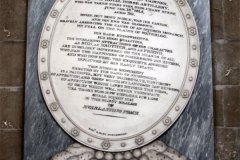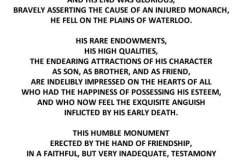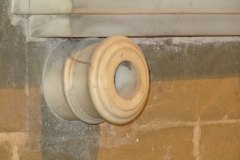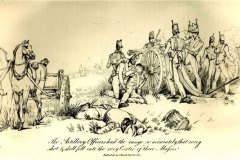(1785-1815)
Artillery Officer killed at Waterloo
Major Robert Macpherson Cairnes was an artillery officer during the wars against Napoleon, mostly serving in the Peninsular War, and was killed in the thick of the Battle of Waterloo. His monument in Canterbury Cathedral (Images 1,2) is on the north wall of the nave. It has an inscription on an oval plaque toppling over on cannonballs set amidst a battlefield. The memorial is supported by two brackets in the shape of cannon mouths (Image 3). It all suggests that his was a life cut short by the deadly vagaries of his profession.
Cairnes was credited with greatly improving the organisation of the Field Artillery, which ultimately led to the abolition of the Drivers Corps in 1822. In reports published immediately after Waterloo his name and achievements were among the first to be hailed. The Gentleman’s Magazine wrote: “In the list of Heroes who fell gloriously in the hour of victory, on the 18th inst at Waterloo . . . the name of Major Robt. Cairnes, of the Royal Horse Artillery, may stand among the foremost.”
Cairnes came from a Scottish family that had been part of the Plantation of Ulster in the early 17th century. He was the son of Major William Cairnes (1743-1789) of the 39th Regiment of Foot and his second wife Jane Heyland, of Coleraine. In 1792 his widowed mother married William Cuppage (1756-1832) an artillery captain, who rose to be a Lieutenant-General. Cuppage was commander of the artillery in Kent for most of Cairnes’ service and in 1806 became Inspector-General of the Royal Carriage Department, Woolwich, which made gun carriages. Cairnes wrote many letters to Cuppage suggesting how the artillery could be better organised and bemoaning, at times, the poor treatment of the artillery by Army commanders.
Military career and engagements
- 1799 gentleman cadet, Royal Military Academy, Woolwich
- 1801 2nd Lieutenant
- 1803 1st Lieutenant
- 1807 siege of Copenhagen
- 1808 2nd Captain, No 4 Company, 10th Battalion of Artillery
- 1810 defence of Cadiz
- 1811 battle of Barossa
- 1812 siege of Badajoz; badly injured in powder mill explosion at Seville
- 1813 battle of Vitoria
- 1814 joins I Brigade of Royal Horse Artillery; battle of Bayonne; appointed brevet Major – brevet promotions were an honour for bravery or meritous service but without the pay or authority of that rank
At Waterloo on 18 June 1815 Cairnes’ troop was deployed shortly after the battle started, although rain had left the ground in a difficult state for moving the artillery. The troop was involved in the fight to hold the strategically important Hougoumont Chateau, on Wellington’s right flank. Cairnes was directing the firing of howitzers with shrapnel shells when he was killed by a cannonball. In The Battle Of Waterloo by “A Near Observer”, the author says of the Hougoumont engagement: “The artillery officers had got the range so accurately, that almost every shot and shell fell in the very centre of [the enemy’s] masses.” This quote is used with a sketch (Image 4) by the artist Captain George Jones (1786-1869) made on the battlefield.
Cairnes’ Canterbury memorial was executed by Thomas White Longley, the cathedral’s master mason. It is also signed by Robert and Mary Rushbrooke – probably Robert Rushbrooke (1752-1829), a barrister, and his wife Mary Rushbrooke, nee Grubb, (1755-1844), of St George’s Street, Canterbury. There is another monument to Cairnes in the church of St Francis in the town of Waterloo, erected by Burke Cuppage, probably Cairns’ half-brother, who had fought at Waterloo as an artillery lieutenant. Cairnes is also named on the monument in the same church to all of Wellington’s artillerymen killed in the battle.
Sources and further reading:
A History Of The Family Of Cairnes Or Cairns by H.C. Lawlor; Elliot Stock, 1906
History Of The Royal Regiment Of Artillery by Major Francis Duncan; John Murray, 3rd edition, 1879
List of Officers of the Royal Regiment of Artillery from the Year 1716 to 1899, compiled by General W.H. Askwith; William Clowes and Sons, 4th ed, 1901
Wellington’s Guns by Nick Lipscombe; Osprey Publishing, 2013
J.P.D.




